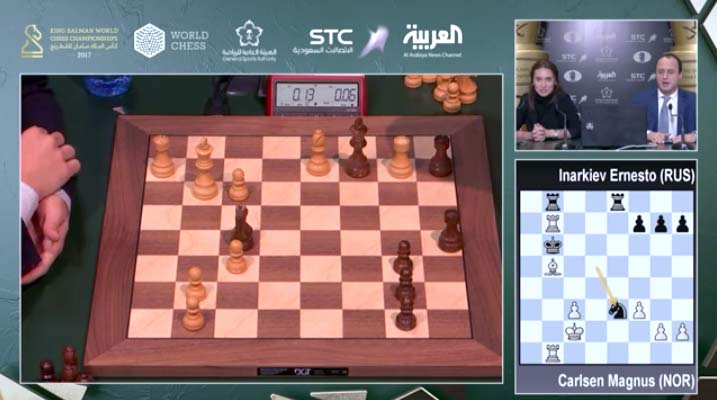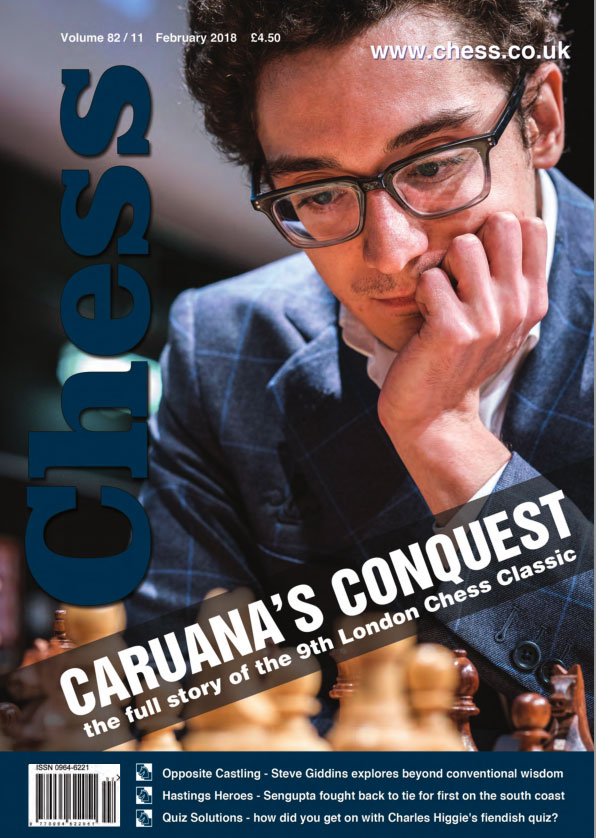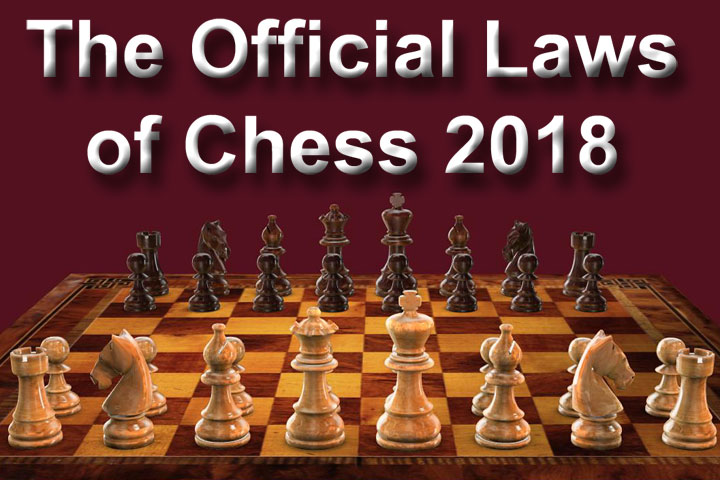What is the law?
By International Arbiter Alex Holowczak
On 1st January 2018, new Laws of Chess were introduced, just six months after the previous revision. They tidy up the 1st July 2017 revision, in which changes were rushed and had not gone through the normal levels of scrutiny.
The hot topic in the chess world as I write this is the King Salman World Rapid & Blitz Championship. While pre-tournament there was much conversation about the merits of holding it in Saudi Arabia, sadly much of what happened coming away from the tournament was comment on the Laws of Chess and the quality of arbiting.
When I took up arbiting, the 2009 Laws of Chess were current. The illegal move rules had one or two woolly edges, but in principle were simple enough — if a player made an illegal move, for the first two give two minutes to your opponent, and a third loses the game. In Blitz, one illegal move lost the game.
The definition of an illegal move was simple. It was the result of not moving a piece the way it should: moving a bishop like a rook, for instance, or not getting out of check. If the player did something of that nature before pressing his clock, it was an illegal move. In general, it appeared to be a non-issue in many amateur tournaments I was involved with, and there didn’t appear to be any major illegal move scandals reported by the world’s chess media at the time. If there was an illegal move that was incorrectly handled, no one really noticed — the penalty was comparatively trivial to what it would become.
In the 2013 Laws of Chess — which came out a year late in 2014 – things changed. The Laws changed to two illegal moves losing for classical chess, and one for Rapid & Blitz. The reason reported at the time was that players were making illegal moves deliberately when short of time, to gain time while the arbiter adjusted the clock.
As a result of this, amateur players could now lose games of chess due to carelessness that they couldn’t before. Meanwhile, the professionals would play in tournaments like the World Cup with large numbers of arbiters, which were able to opt in to using the 'Competition Rules', which allowed them to use the classical Laws, i.e. that two illegal moves would lose. Consequently, the people with the most to gain by cheating in the way they were trying to prevent still could, and the amateurs now had their games of chess spoiled through carelessness. It was a step in the wrong direction.

Two kings in check! Carlsen-Inarkiev at the World Blitz | Source: ChessCast
In time for the 2018 tidying up, suddenly the Law was changed, and now two illegal moves would also lose in Rapid & Blitz. The rationale for this is that by default, the same rules apply for classical, Rapid and Blitz chess, which might be important at an event like the World Cup with so many different types of game.
Certain issues with the new rules came to light due to the high-profile clash between Carlsen-Inarkiev in Riyadh, where in the diagram below White played 27 Rxb7+.
The arbiter had just moved away to look at one of the other games — in Riyadh, there was one arbiter for every five games. Inarkiev then played 27...Ne3+ and pressed the clock. This is an illegal move, and if Carlsen had brought this to the arbiter’s attention, the arbiter should have awarded Carlsen the win because of Inarkiev’s illegal move. [The situation is extensively described in the ChessBase report World Blitz - Day 1]
However, for whatever reason, Carlsen instead played 28.Kd3. At this point, Inarkiev immediately stopped the clock and signalled for an arbiter. The arbiter arrived and declared the game lost for Carlsen, ruling that 28.Kd3 was an illegal move. Sadly, the arbiter had made the wrong decision, and as the players were leaving the playing area, Chief Arbiter Takis Nikolopoulos overruled the board arbiter, and said that the game should resume from the position after 28.Kd3, which was a legal position. Inarkiev refused and decided to appeal Nikolopoulos’s decision, but the Appeals Committee upheld the decision. Inarkiev refused to play on, and so Carlsen won the game.
Various commentators have now picked up on the following position:
This arose after the moves 1.e4 d6 2.Bb5+ h5. The commentators then provide the following two options for White:
- Claim the illegal move, and get an extra minute in Blitz, or two in Rapid
- Play 3.Qxh5 and carry on
In classical chess, if this happened, White would have the following options
- Claim the illegal move and get two extra minutes
- Play 3.Qxh5 and carry on
The options are the same. The only change is what happens if the arbiter sees the illegal move. Again, in all three formats, if the arbiter observes 2...h5 and the clock being pressed, then the game can be reset to the position before 2...h5 and White gets extra time.
The difference is what happens after 3.Qxh5. If at this point the problem is brought to the arbiter’s attention in classical chess, then the game goes back to the position before 2...h5, and the game continues. You can do that because the players will have maintained a scoresheet. In Rapid & Blitz, you can’t do that, because the players are not obliged to maintain a scoresheet. As a result, because the position on the board is legal, the game continues, as if no illegal move has been made.
If there are no scoresheets, what other options are available? The Laws of Chess permit a tournament to use the Competition Rules (i.e. the classical Laws) for Rapid & Blitz if two conditions are met:
- There is one arbiter for at most three games in Rapid (one arbiter per game in Blitz)
- Each game is recorded manually by the arbiter or an assistant, and if possible by electronic means
The World Championships in Riyadh couldn’t meet these requirements, but in my opinion they are much too restrictive. As a suggested improvement for the next revision, I would think it enough that if all games were being recorded on a live board, then this should be enough to use the Competition Rules. That way, the World Championship can use the live boards rather than the scoresheet to see the position, and go back to the position before 2...h5 and play on from there. Meanwhile the local Rapid tournament in a town hall in the English countryside, played with plastic pieces and plastic boards, can use the new Laws happily because there is no evidence that anything other than a normal game of chess has taken place.
What do you do if a live board fails? Well, what do you do if you can’t reconstruct the game from the scoresheets the arbiters have kept, or the players have kept in a classical game? Live boards ought to be reliable enough these days, and it isn’t clear to me that arbiters are able to record the moves at the end of a Blitz game any better than the technology can.
Is this the compromise that works for everyone?
A contrasting view was published in the same edition of CHESS Magazine by regular columnist John Saunders, who believes that the rules are too important to be left to arbiters!
John Saunders on Chess
In my November 2017 column in CHESS Magazine I voiced misgivings about changes to the laws of chess over the past twenty years and how the constant chopping and changing of the rules and the insertion of excessive detail has led to confusion, irritation and acts of opportunism at the board. We didn’t have to wait long before this was exemplified by the now notorious Carlsen-Inarkiev game at the 2017 World Blitz Championship. I’ve no doubt that the circumstances of this game are detailed elsewhere, so won’t go over them here, but it is pretty clear that Inarkiev sought to capitalise on the amendment to the laws concerning illegal moves.
Since then we’ve read comments from arbiters attempting to play down the problem with the laws, stressing that everything will be fine from 1st January 2018 onwards when the new rules bring blitz into line with standardplay, so that a first illegality will not result in loss of the game. But will it be fine? The question has arisen about what now happens after a sequence of moves such as 1.e4 d6 2.Bb5+ h5:
Obviously White could claim the last move was illegal and be awarded extra time on his clock, but as the laws now read he has a more attractive option: he could waive his right to claim and simply continue 3.Qxh5!!.
Black would now be obliged to deal with the check on his next turn, let’s say, 3...c6, to which White could reply 4.Qxh8. I think most of us would prefer to win the exchange to having an extra minute on our clock, but it makes a mockery of the rules of chess as we have come to understand them (not to mention causing a major headache to programmers of chess software whose products will not allow the above sequence to be entered into their databases).
Personally, what I would like to see is a reversion to the philosophy of the laws as they were before the Ilyumzhinov regime came to power. In those days the laws of chess were treated with more respect and people hesitated before making changes to rules which had developed and coalesced over the course of hundreds of years, with input from innumerable, unidentified people from many countries, much as England’s much admired common law had come into being. What really pains me is the arrogance of modern law-makers (and not just chess law-makers) in taking it as read that they can do better than their ancestors. The evidence of the past twenty years suggests the opposite.
On the specific matter of the law concerning illegal moves, it seems to have become axiomatic that some sort of penalty has to be imposed for an illegal move (or at least a second illegal move) by a particular player. But I am by no means convinced of the need for penalising illegal moves. Why not go back to the laws as they once were whereby the laws merely required the restoration of the last legal position? It may perhaps be argued that this would still leave the door open to sharp practice, but this could and should be dealt with by arbiters under article 12 governing the behaviour of players.
Article 12 is one of the more sensible, necessary and better drafted of the recent laws, but it does place a premium on good judgement and decisive action by officials. One gets the impression that chess officials and politicians shy away from it. They prefer to have specific detail in the laws to rely on when making decisions, rather than having to rely on the generalities of laws such as article 12, but I think that could be root cause of all the problems that have arisen. As always, the devil is in the detail, and it is these well-meaning but botched attempts to hard-code solutions and penalties into the laws to handle specific situations that have led us to the current mess.
The above articles were reproduced from Chess Magazine February/2018, with kind permission.
About CHESS Magazine

CHESS Magazine was established in 1935 by B.H. Wood who ran it for over fifty years. It is published each month by the London Chess Centre and is edited by IM Richard Palliser and Matt Read. The Executive Editor is Malcolm Pein, who organises the London Chess Classic.
CHESS is mailed to subscribers in over 50 countries. You can subscribe from Europe and Asia at a specially discounted rate for first timers, or subscribe from North America.
UK’s most popular CHESS Magazine — established 1935! All the regular features of the UK’s best-selling CHESS magazine plus more! In this issue:
- The Comeback — Only having 2/4 didn’t prevent Deep Sengupta from winning Hastings
- Anatoly’s Chess Festival — Carl Strugnell explains all about the famous Cap d’Agde event
- War not Draw — After a slow start, the London Chess Classic finished with a bang
- How Good is Your Chess? – Daniel King takes a look at Magnus Carlsen’s love of blitz
- Don’t be a Kotov clone! — Steve Giddins on less conventional aspects of opposite castling
- Never Mind the Grandmasters… — Carl Portman examines the similarities between darts and chess
- Find the Winning Moves — Can you do as well as the players at the London Chess Classic?
- Remembering the Grand Prix Master, Dave Rumens — David Levens pays tribute to his late friend and attacking whizz
- Christmas Quiz Solutions — How did you fare with Charles Higgie’s festive puzzles?
- Illegal Moves — Alex Holowczak on the new laws of chess and handling illegal moves
Plus all the regular features such as: How Good is Your Chess?, Saunders on Chess, Find the Winning Moves, Never Mind the Grandmasters, Studies, Home & Overseas News, Calendar and Book Reviews.
Download a free PDF preview of this issue!

ChessBase software from Chess & Bridge
 Pieces, Pawns and Squares
Pieces, Pawns and Squares
Adrian Mikhalchishin
ChessBase PC-DVD;
running time: 4 hours, 45 minutes
RRP £26.99 SUBSCRIBERS £24.29
This DVD is all about technique: “How we conduct our plans, our ideas [...] improvement of the position [...] how we conduct it in the best and fastest way.” Needless to say, this is a big subject. The material is split into four main parts, namely: how to create weaknesses; how to conquer and exploit important squares; pawns; and tests. There is also a database offering a further 57 examples of positional play with very brief notes (a line or two at best).
Mikhalchishin is a ChessBase stalwart. I always find his DVDs to be very instructive, but they demand a lot of work from the chess student. His delivery is fast and heavily accented. Viewers will need to keep a flexible trigger-finger on the ‘pause’ button.
The first game shows Judit Polgar exploiting the d5-square in a typical Najdorf Sicilian against Anand. Watching the moves and listening to the explanatory commentary really brings home just how much of a sustained effort is required in order to earn a victory at the top level. This is apparent throughout most of the examples on the DVD, but the presenter does a very good job of instilling confidence in the viewer as he explains the ideas behind the plans, often using different illustrative snippets to illustrate a single theme.
This example — taken from the interactive test section, where playing the best move on the screen opens up the next video clip – is a case in point.
At first impression, it looks like Black can only hope for the opponent to make a big mistake in order to have serious winning chances. The potential weakness at g4 is very difficult to attack and the white position looks solid everywhere else. However, Karpov makes this position look like a forced win. The plan starts with 29...Ra6!. This is difficult to find as I’m sure most players would automatically be thinking of placing the rook on f8, which offers advantages only of the illusory kind. After the further moves 30 Ke2 Na4 31 d4 Bb6 the b-pawn collapsed under the pressure and White couldn’t hold on much longer (0-1, 42).
I found extra examples of this idea in the database, featuring Fischer and Geller. Indeed, one of the games shows Geller using the manoeuvre to target Fischer’s b-pawn towards the end of another Najdorf Sicilian, so perhaps Fischer picked up the idea from there. Geller worked with Karpov, of course...
Summing up, I found the examples to be very instructive indeed, but this material is not for beginners. One can imagine Daniel King breaking down the material a little further to make it much more accessible, although Mikhalchishin’s style and delivery ensures this DVD is for much more experienced players and students, who should be able to learn a considerable amount from this highly respected trainer.
Sean Marsh
Order Pieces, Pawns and Squares - Adrian Mikhalchishin online from
The London Chess Centre or Chess4Less (USA)





















 Pieces, Pawns and Squares
Pieces, Pawns and Squares




